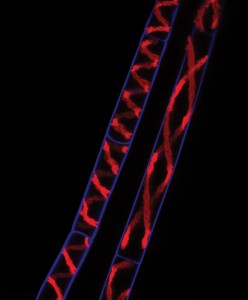 Our paper on the conservation of Ethylene , a key plant stress hormone, which turns out to be functional in the charophyte green alga Spirogyra, appeared in the first week of January 2015. It was the result of a complex collaboration with my colleague Caren Chang, and the efforts of five talented undergraduates, graduates, and postdocs. Of course the close relationship between charophytes and land plants has been a long-term interest of mine (and was the subject of my dissertation), but this has been a particularly pleasing project for several reasons.
Our paper on the conservation of Ethylene , a key plant stress hormone, which turns out to be functional in the charophyte green alga Spirogyra, appeared in the first week of January 2015. It was the result of a complex collaboration with my colleague Caren Chang, and the efforts of five talented undergraduates, graduates, and postdocs. Of course the close relationship between charophytes and land plants has been a long-term interest of mine (and was the subject of my dissertation), but this has been a particularly pleasing project for several reasons.
My original interest in the problem dates back over 15 years, to shortly after I came to the University of Maryland. At that time Caren and another colleague, Steve Mount, had shown that the ethylene receptor in plants is homologous to a protein in cyanobacteria that also appears to function as an ethylene receptor. Strikingly, the receptor is absent from all of the chlorophyte green algae that have been examined, , including Chlamydomonas and Ostreococcus. However, I was aware that the chlorophytes are only distantly related to land plants — the base of the green algal divergence is minimally a billion years old, and perhaps much older — and that there are living charophytes that are much more closely related to plants. Chang and Mount had postulated that the ethylene signaling pathway had been introduced into the plant lineage with the endosymbiotic origin of plastids. If true, then the obvious explanation for its presence in plants and cyanobacteria, but absence from chlorophytes would be that it was present in the ancestor, lost in the chlorophytes, but retained in the charophytes.
I recognized that in the 1990s, but testing that hypothesis would have been a major undertaking, and we didn’t pursue it further at the time. Jump forward ten or twelve years and DNA sequencing technologies have changed dramatically. We routinely do high-throughput transcriptome sequencing in my lab, and Dr. Ruth Timme, when a postdoc in my lab, had noted the presence of ethylene-related genes in several charophyte transcriptomes. That was using 454, an older sequencing technology, but when we repeated her work with Illumina (an inexpensive, very high throughput, but short read technology) we were able to assemble almost every gene in both the biosynthesis and reception/signal transduction pathways. The pathway was particularly well conserved in Spirogyra, which was a bit surprising because it is such a structurally simple organism.
The project was initially spearheaded by Jay Thierer, who was then an undergraduate at Maryland, and is now a graduate student at Johns Hopkins. Jay did the Illumina sequencing (with bioinformatics help from a grad student, Ted Gibbons), and began a series of transformation experiments in Caren’s lab. The results were promising and exciting; the Spirogyra homolog of the receptor, ETR1, could partially rescue triple-mutants of Arabidopsis (there are four redundant receptors, so it is hard to see an effect in a plant lacking only one of them). Unfortunately Jay graduated shortly after generating the first recombinants, and had to move on to other things. The work was subsequently picked up by Chuanli Ju (a postdoc with Caren) who demonstrated the function of several other steps in the pathway, and later on by Bram Van De Poel, a postdoc from Belgium. Bram was able to measure ethylene emission by Spirogyra, and, critically, found a phenotype; Spirogyra cells elongate in the presence of ethylene, and do so in a dosimetric manner. The higher the ethylene exposure, the greater the cell elongation (within reason).
There are a couple of things I particularly like about this paper. First of all, it is the result of a true collaboration, where everyone contributed a distinct set of skills. It wasn’t just a matter of convenience or access to resources; the project would have been very challenging for either Caren’s lab or my own, but working together we were able to do something really challenging. Second, this is a case where we started with a bioinformatic inference, then tested individual components of that hypothesis with molecular genetic methods, and finally, leveraging off of those insights were able to identify the phenotype (the final question, what the environmental and adaptive significance of the hormone is for Spirogyra remains an open question).
And finding the ethylene hormone system in Spirogyra is a big deal. Many plant physiologists have assumed that it (and other plant hormones) are unique to land plants. At least in the case of ethylene we have shown that is not the case, and that Spirogyra uses a system that is unambiguously homologous to that of land plants. For many people this will be a very surprising observation. Nor are we the first to try to answer this question. I should give a big shout-out to Burkhard Becker, who made similar observations to ours with 454 sequencing, but didn’t go as deeply into the molecular genetics as we did. And ethylene isn’t the only plant hormone that seems to be present in charophytes, so we have lots more work to do.
http://www.nature.com/articles/nplants20144